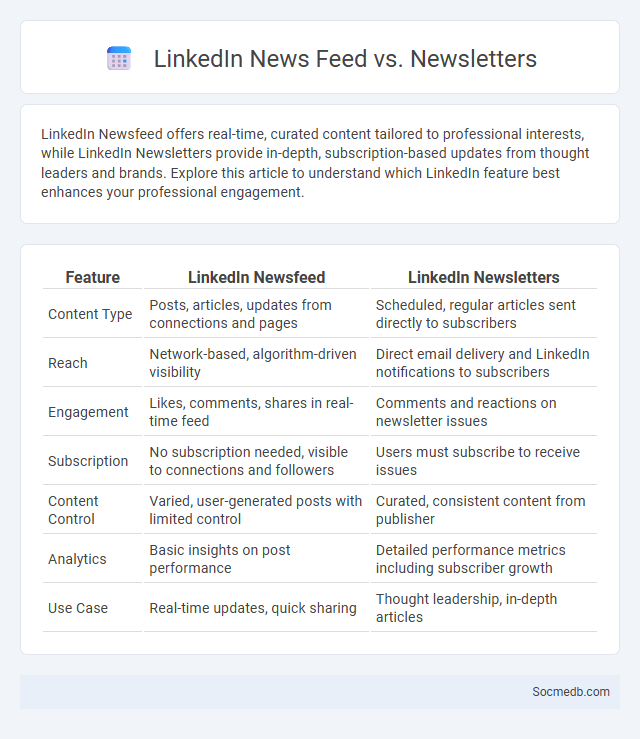
Photo illustration: LinkedIn Newsfeed vs Newsletters
LinkedIn Newsfeed offers real-time, curated content tailored to professional interests, while LinkedIn Newsletters provide in-depth, subscription-based updates from thought leaders and brands. Explore this article to understand which LinkedIn feature best enhances your professional engagement.
Table of Comparison
| Feature | LinkedIn Newsfeed | LinkedIn Newsletters |
|---|---|---|
| Content Type | Posts, articles, updates from connections and pages | Scheduled, regular articles sent directly to subscribers |
| Reach | Network-based, algorithm-driven visibility | Direct email delivery and LinkedIn notifications to subscribers |
| Engagement | Likes, comments, shares in real-time feed | Comments and reactions on newsletter issues |
| Subscription | No subscription needed, visible to connections and followers | Users must subscribe to receive issues |
| Content Control | Varied, user-generated posts with limited control | Curated, consistent content from publisher |
| Analytics | Basic insights on post performance | Detailed performance metrics including subscriber growth |
| Use Case | Real-time updates, quick sharing | Thought leadership, in-depth articles |
Understanding LinkedIn Newsfeed: Features and Impact
LinkedIn Newsfeed offers a dynamic stream of professional updates, industry news, and personalized content tailored to your network and interests. Its algorithm prioritizes relevant posts based on engagement, connections, and trending topics, enhancing your visibility and interaction opportunities. Understanding these features enables you to strategically share content and engage with influencers, boosting your professional presence and impact on the platform.
What Are LinkedIn Newsletters? Key Benefits & Reach
LinkedIn Newsletters are a powerful content format allowing professionals to publish recurring articles directly to their network and subscribers, enhancing visibility and engagement. These newsletters leverage LinkedIn's algorithm to notify followers about new issues, boosting reach beyond regular posts and fostering a dedicated readership. Key benefits include building authority in niche industries, generating higher user interaction, and expanding professional influence through targeted distribution.
Newsfeed vs. Newsletters: Core Differences
Newsfeed algorithms prioritize real-time content updates, delivering a continuous stream of posts, shares, and comments tailored to user interactions and preferences on platforms like Facebook and Instagram. Newsletters provide curated, scheduled content directly to subscribers' inboxes, often offering in-depth insights, special offers, or personalized information that bypasses algorithmic filtering. This distinction highlights the immediacy and social interaction emphasis of newsfeeds versus the targeted, controlled communication style of newsletters.
Audience Engagement: Newsfeed vs. Newsletter Performance
Audience engagement on social media platforms shows marked differences between newsfeed interactions and newsletter responses, with newsfeeds typically generating higher immediacy and volume of clicks due to real-time updates and multimedia content. Newsletters tend to yield deeper engagement metrics, including longer reading times and higher conversion rates, as they target a more specific and opted-in audience. Analyzing click-through rates, open rates, and interaction patterns reveals that integrated strategies combining both formats optimize overall audience retention and action.
Content Types Best Suited for Newsfeed
Visual content such as images, videos, and infographics dominate social media newsfeeds due to their high engagement rates and ability to quickly convey information. Short, captivating captions combined with trending hashtags increase visibility and interaction, making your posts more likely to appear in users' feeds. User-generated content and live streams foster authenticity and community connection, enhancing trust and loyalty among followers.
Newsletter Strategies for Thought Leadership
Effective newsletter strategies for thought leadership involve consistently delivering high-value, insightful content tailored to your audience's interests. You should incorporate data-driven insights, expert interviews, and actionable tips that position you as an industry authority. Engaging subject lines and personalized messaging enhance open rates and foster stronger connections with your readers.
Distribution Algorithms: Newsfeed vs. Newsletters
Social media distribution algorithms prioritize content based on user engagement, relevance, and recency, making newsfeeds dynamic and personalized streams of information tailored to your interactions and preferences. Newsfeed algorithms analyze behaviors such as likes, comments, and shares to rank posts, ensuring you see content with the highest predicted interest or value. In contrast, newsletters use a more curated and direct distribution method, delivering selected content to your inbox based on subscription choices, offering a controlled and less algorithmically varied experience.
Measuring Success: Analytics and KPIs Comparison
Measuring success on social media relies heavily on analytics platforms like Facebook Insights, Twitter Analytics, and Instagram Insights, which track key performance indicators (KPIs) such as engagement rate, reach, and conversion rate. Comparing KPIs across platforms helps identify which channels drive the most traffic and generate the highest return on investment (ROI). Tracking metrics like follower growth, click-through rates, and bounce rates enables marketers to optimize content strategies for better audience targeting and improved campaign effectiveness.
Choosing the Right Format for Your LinkedIn Goals
Selecting the ideal format for your LinkedIn content directly impacts engagement and helps achieve your professional goals. Videos generate higher interaction rates, while articles establish thought leadership within your industry. Tailoring posts to your target audience's preferences ensures your message resonates and maximizes LinkedIn's networking potential.
Best Practices for Leveraging Both Newsfeed and Newsletters
Maximize engagement by tailoring content specifically for both your social media newsfeed and newsletters, ensuring each platform's unique format and audience preferences are addressed. Incorporate a mix of visual elements, concise messaging, and actionable calls to action to boost click-through rates and foster community interaction. Monitor analytics consistently to refine your strategy, enhancing the relevance and impact of your posts and email campaigns for your audience.
 socmedb.com
socmedb.com